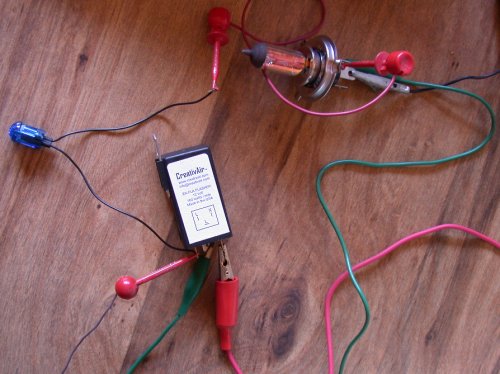 testing Bill
VonDane's wig-wag flasher, driving just one 100w halogen bulb, and a little
blue Radio Shack panel indicator bulb
testing Bill
VonDane's wig-wag flasher, driving just one 100w halogen bulb, and a little
blue Radio Shack panel indicator bulbAugust, 2004 AVIONICS, ELECTRICS, & CONTROLS
Aug 2 - Back from OSH - spent most of the day studying avionics & panel choices & planning. Numerous emails to vendors. Studying electrical, lighting, grips, switches, panel, etc. Started making list of all panel switches & indicators, as well as grip switches & their functions. Ordered crimper jaws and automatic wire stripper from SteinAir. Ordered low fuel warning system from Pillar Point. Ordered electroluminescent panel glare shield lighting from Aircraft Extras. Spent a couple hours processing my OSH pictures. 10 hr
I have finalized my nav/comm/GPS choice as the GNS530. The 430 is too small and the GNS480 (CNX80) is too difficult to use. There are also some areas where the 530 is more compatible with the rest of my avionics. I emailed Garmin about options pricing and got a quite prompt reply with the following info:
1. What is difference in retail price of GNS530 vs GNS530A?
The GNS 530 is $14,995. The 530A is $19,995.
2. What is the price of the TAWS option?
The TAWS upgrade is $8000.
3. What is the difference in price between the GTX330 and GTX330D?
The GTX 330 is $4995. The 330D is $9,995.
4. Is there any additional charge for TIS capability?
No, that is included with the transponder.
So, the 16 watt 530A is an incredible $5000 more than the standard 10 watt 530. All the options are incredibly expensive. I will definitely be going with the 10w 530.
Aug 3 - Spent a few more hours on avionics/electric/panel planning. Sent emails to David at Avionics Systems, detailing our starting point, and with details of EXPBUS replacement circuit ideas. 3.0 hr
Aug 5-8 - updating web site while at NHIS track for 4 day weekend of motorcycle roadracing
Aug 9 - bench tested CreativeAir wig-wag flasher. Found it doesn't work with just one light. I can only flash one landing light now, because I upgraded the other one to HID. Spent all afternoon working on that, exchanging numerous emails with Bill VonDane about it, and researching a better suited flasher from Trico. With Trico engineer's help, found that the ideal one for a single light would be the EL12. I also did various testing and found that a cheapie little 12 volt Radio Shack panel indicator lamp (272-335C) made the CreativeAir flasher work perfectly. Not only does this work well, it works perfectly for the application, because (due to wattage differences) it causes the wig-wag to go into about a 75/25% cycle mode, where the landing light is on 75% of the duty cycle and the panel light is on 25% of the cycle. Even the blue color seems ideal for this use on the panel. Perfect. Also, received electroluminescent panel lighting kit from Aircraft Extras and the automatic wire stripper from SteinAir. More studying avionics sources, researching panel layout. Ordered hub for laptop with BMA EFIS. Also added new "mailing lists" page to web site. 8.0 hr + 1.0 doc
 testing Bill
VonDane's wig-wag flasher, driving just one 100w halogen bulb, and a little
blue Radio Shack panel indicator bulb
testing Bill
VonDane's wig-wag flasher, driving just one 100w halogen bulb, and a little
blue Radio Shack panel indicator bulb
Aug 10 - working on electrics research all morning. Bench tested electroluminescent lighting. Seems to work fine. I think it'll be great. Received the Lincoln TIG welder I ordered at OSH04. Spent most of the afternoon setting up the TIG welder. Later, received Pillar Point Low Fuel Warning system and my MAC mini air drill via UPS. Tested low fuel warning system; it worked great 6.0 hr
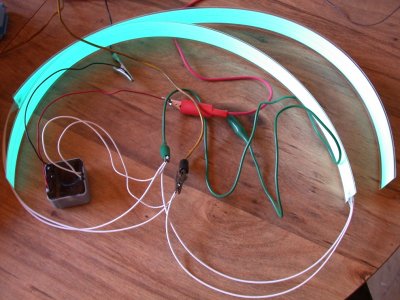 bench testing the electroluminescent glare shield lighting. They are
actually blue-green all over. The camera just made one end look white.
bench testing the electroluminescent glare shield lighting. They are
actually blue-green all over. The camera just made one end look white.
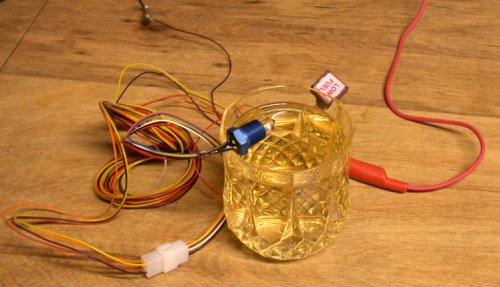 Here is one of the 2 low fuel indicator systems, being bench tested.
Dip the sensor in the glass of water and the light goes out. Take it
out of the water, and it starts flashing. I also found out that if I
take it partially out of the water, the indicator starts glowing brighter
& brighter until it starts flashing, so that's good to know as a little
advance warning that it's about to go off. The Pillar Point web site
shows the indicators as smaller round ones, which was one reason I chose the
more expensive Pillar Point low fuel warning system over the one from
Aircraft Extras. I emailed Pillar Point about it, and Dennis Douglas,
the honcho there, will send me the round ones.
Here is one of the 2 low fuel indicator systems, being bench tested.
Dip the sensor in the glass of water and the light goes out. Take it
out of the water, and it starts flashing. I also found out that if I
take it partially out of the water, the indicator starts glowing brighter
& brighter until it starts flashing, so that's good to know as a little
advance warning that it's about to go off. The Pillar Point web site
shows the indicators as smaller round ones, which was one reason I chose the
more expensive Pillar Point low fuel warning system over the one from
Aircraft Extras. I emailed Pillar Point about it, and Dennis Douglas,
the honcho there, will send me the round ones.
Aug 11 - electric system & Subaru research & emails. Place order with DigiKey for voltage regulator for the ethernet hub I ordered. Went to Radio Shack and got some electronic components and more jumper wire sets for bench testing. 7.0 hr
Aug 12 - more electric, EFIS, and Subaru research. Reviewed AOA (Angle of Attack) tape and added more ideas to panel switches and indicators list. Later on, worked on more panel planning, including putting the actual BMA EFIS display and other small components right on the panel, to see how they fit. I seem to have somewhat less space, especially vertically, than shown in the ePanelBuilder site. 6.5 hr
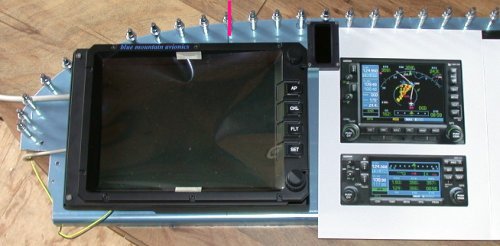 I tried
laying the BMA EFIS and the AOA on the panel, and putting a full-size
picture of the GNS530 on as well, just to see how it would fit. The
red
line at the top marks the centerline of the pilot's stick. This was as close as
I thought I could get the BMA and AOA to where I wanted.
I tried
laying the BMA EFIS and the AOA on the panel, and putting a full-size
picture of the GNS530 on as well, just to see how it would fit. The
red
line at the top marks the centerline of the pilot's stick. This was as close as
I thought I could get the BMA and AOA to where I wanted.
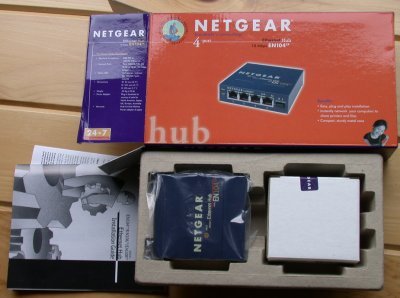 This is the EN104
hub I bought so I could have the autopilot and laptop connected to the BMA
at once. I decided it was a big waste of space, weight, and current,
not to mention the $30 or so I spent to get it and the regulator chip.
This is the EN104
hub I bought so I could have the autopilot and laptop connected to the BMA
at once. I decided it was a big waste of space, weight, and current,
not to mention the $30 or so I spent to get it and the regulator chip.
Aug 13 - put panel in plane and marked on it where main components will go. The AOA is problematic, because I want it centered and up high, and the Blue Mountain Avionics EFIS takes up all that space. After putting it in the plane, I put the seats in and sat behind it. I initially planned to shove the BMA all the way to the left and squeeze the AOA in just to the top RT of that, as shown drawn on the panel in the pic. Then I had some better ideas, including a GREAT one of putting the AOA display hanging from the bottom of the glare shield. That's the closest I'll get to a HUD. That's definitely the place to put it. It will hang down over the bezel of the BMA EFIS, but not over the actual display. It'll be high and centered. Perfect. I also thought I'd put the Ray Allen trim/flap indicators on the LT, top, & RT of the BMA, but later decided to put them below the panel, in the center. Another important test I did was to see how far to the RT I can easily reach, as I now plan to put the GRT EFIS and GNS530 right next to the BMA EFIS, with the SL30 nav/comm2, audio, and transponder to the RT of that. I found I can easily reach all the way to the copilot centerline, without leaning forward, so that'll work. 2.0 hr
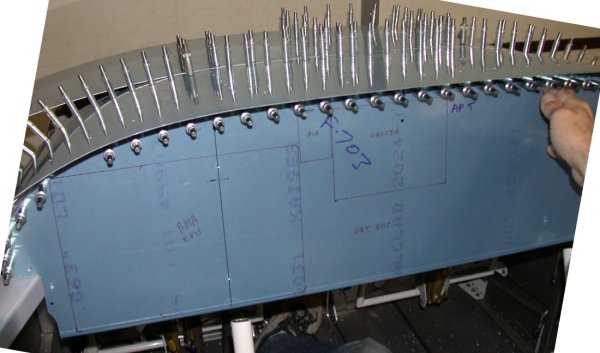 Here is the panel sitting in the plane, with the first major components
marked out. As you can see from my RT hand, I can easily reach over to
the passenger centerline, so I know that putting the audio, transponder, and
comm/nav2 in the 3rd stack will work fine. This gets the GRT EFIS
closer to me than originally planned.
Here is the panel sitting in the plane, with the first major components
marked out. As you can see from my RT hand, I can easily reach over to
the passenger centerline, so I know that putting the audio, transponder, and
comm/nav2 in the 3rd stack will work fine. This gets the GRT EFIS
closer to me than originally planned.
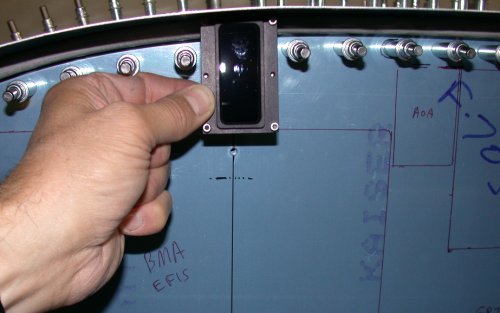 This is
the ideal placement for the AOA display, not where I drew it onto the
panel. I will make something to hold it here. As you can see,
the glare shield above it is curved and slanting down above the indicator,
so my mounting box will have to take that into consideration.
This is
the ideal placement for the AOA display, not where I drew it onto the
panel. I will make something to hold it here. As you can see,
the glare shield above it is curved and slanting down above the indicator,
so my mounting box will have to take that into consideration.
Aug 15 - Looking over the AOA install manual & realize they suggest a glare shield mounting & offer an optional mount kit for it. I thought I was so brilliant in thinking that one up! I contacted Jim Frantz for info about his glare shield mounting option, but I think I'll just make my own. Jim replied later, and said his glare shield mounting option is $50. I don't know how well it will mate to the curve of the glare shield. I will probably use the new TIG welder to bend & weld up a little box out of 6061 that'll hang under the glare shield. The mounting needs to be custom, because the panel and glare shield are neither straight nor horizontal at the pilot's centerline. I emailed Jim some questions about his mounting configuration, but he didn't bother to reply, so I'll make my own. I also noted in reading the AOA manual that it says repeatedly not to use the AOA as a primary flight instrument. Doesn't that sort of negate its value? They sure don't tell you THAT on their web site! Then I moved on to the Flaps Positioning System (FPS), made by Show Planes in Oregon, sold in Van's Accessories Catalog. Started out by figuring out what goes where. There was some initial confusion, because I'd also ordered Van's flap motor relay system, and I'd put components from both systems into the same box about a year ago. After thinking about it and looking at the prints for both systems, I doubt I'll be needing the motor relay. My Infinity grips also came with yet another relay board; this one with 3 relays on it; 2 for trim and one for flaps. Installed, adjusted, tested FPS. Mounted FPS control box and crimped in the splices to the flap motor. Now, it just needs connections to power, ground, and switch. It came with a big ole 15a switch, but I can't believe it's needed. Surely, there is a relay in the control box. I will call Show Planes & find out for sure. Then I went back to looking at my Infinity grips again. I was strongly questioning the need for the 3 relay board they sold me, and wondering if they'd sold me something I didn't really need. The paperwork for the Ray Allen servos says they can BOTH be run off a 1 amp breaker, and that the no-load current is only 150ma. The hat switch is rated for one amp, and I assume that's in each direction. 5.0 hr
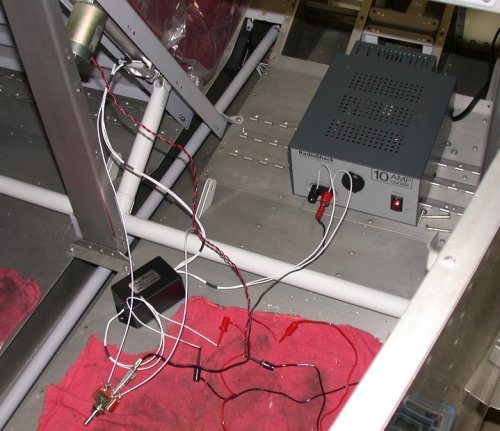 Setup for
testing the FPS - Flap Positioning System. It has pre-selected stops
for 10, 20, 40 degrees of flaps. No way do I want to be holding the
flaps switch down while I watch the indicator to see how many degrees of
flaps I have. I just touch the momentary switch once, and it goes to
10 degrees and stops. Hit it again and it goes to 20 degrees, and so
on. Hit the "up" switch and they come all the way up.
Setup for
testing the FPS - Flap Positioning System. It has pre-selected stops
for 10, 20, 40 degrees of flaps. No way do I want to be holding the
flaps switch down while I watch the indicator to see how many degrees of
flaps I have. I just touch the momentary switch once, and it goes to
10 degrees and stops. Hit it again and it goes to 20 degrees, and so
on. Hit the "up" switch and they come all the way up.
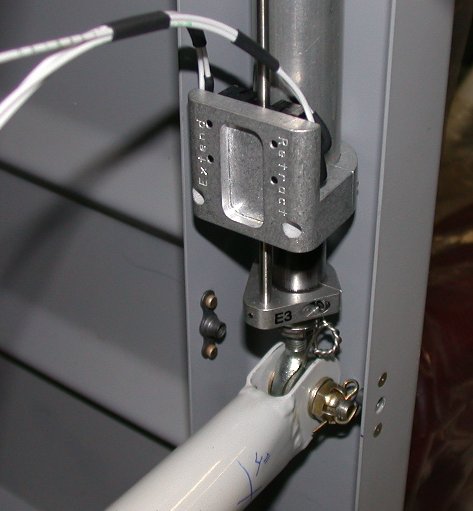 This is a
closeup of the FPS installed. Flaps are extended here. It's nice
when the focus on the camera works right. The blue marks on the
weldment are witness marks I put there to make sure I am getting the same
full flaps travel with the FPS that I was without it. I got full
travel OK. The FPS seems like a nice product.
This is a
closeup of the FPS installed. Flaps are extended here. It's nice
when the focus on the camera works right. The blue marks on the
weldment are witness marks I put there to make sure I am getting the same
full flaps travel with the FPS that I was without it. I got full
travel OK. The FPS seems like a nice product.
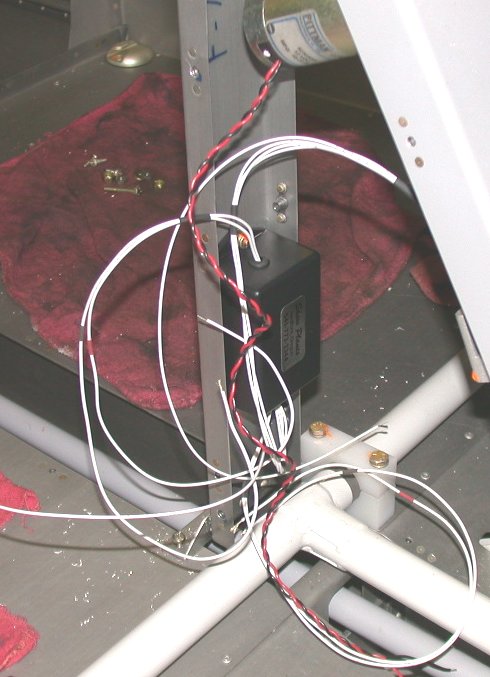 and
here is the FPS control box installed. After I did this, I crimped the
splices between the motor leads and the control box. I'm still looking
for the best way to secure the wires when I am done in there.
and
here is the FPS control box installed. After I did this, I crimped the
splices between the motor leads and the control box. I'm still looking
for the best way to secure the wires when I am done in there.
Aug 16 - After looking at the Infinity and Ray Allen schematics and paperwork more, I figured out that I do need the relay board, not for current, but because each relay in effect converts the SPDT switches in the grip to the DPDT switching that the Ray Allen servos need to see. I don't think Infinity offers DPDT switches; maybe they won't fit in the grip. Worked on more panel planning & emailed David some questions. I noted in the "Pilot's Guide to Avionics" that his business is not listed as a certified avionics repair shop, so that worried me a bit. He says he's qualified, but I need to make sure. BTW, I highly recommend that pilot's guide - click HERE to get one. Then I called Show Planes, but the main guy, Brian, is out until Wed. His Dad thought the system couldn't be used at all with grip switches, but surely he is mistaken; at the worst case, I'd need to use a relay, and I doubt I do. Functionally, the black box must be acting as a relay in order for it to work, plus the wires to the switch look like they're about 22 ga. I'll talk to Brian about it when he returns. Also spent some time studying the PS Engineering catalog and forming several questions I need to ask them about how their 7000CD system works. 6.0 hr
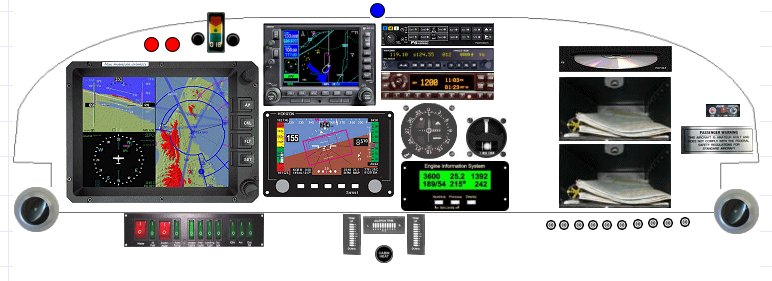 This is the
current panel plan I've told David to go ahead with. It looks kinda
crappy & poorly balanced, but it's what I want functionally. I'm
sure there will be more changes, at least little ones, before I am done with
this.
This is the
current panel plan I've told David to go ahead with. It looks kinda
crappy & poorly balanced, but it's what I want functionally. I'm
sure there will be more changes, at least little ones, before I am done with
this.
Aug 18 - At NHIS again for a 5 day race weekend. Updating the web site when I am not on the track. Called GRT to see where my EFIS is. It's been 4 weeks tomorrow, and they said 3-4 weeks when I ordered it. They said 2 more weeks. I sure hope they don't say "just another week or two" in two weeks; that will not be well received (a la Randy Dierks). Called PraxAir in MI to find out where my TIG welder foot control is. They said it should go out this week. I've been unable to use the welder since I got it a couple weeks ago. Called Show Planes & talked to Brian, the head honcho there. He said the wires to the switch are only for carrying a signal, as I expected, and I can easily use a grip switch directly with it. However, he also said he did not recommend grip switches, because if the "deploy flaps" switch is accidentally selected at high speeds, it can cause a big problem. I will keep that in mind. I think the Infinity grip has the switch recessed a bit in the grip. I will double-check it when I am home again. I also spent some time reviewing Dan Checkoway's and Walter Tondu's canopy pages on their web sites. I realized that both of them mentioned something I hadn't thought of; the canopy frame, at the front, will create a band across the top couple inches of the subpanel that I cannot cut into for deep instruments. I may have to flip my GNS530, GRT EFIS, and radio/transponder/audio panel positioning to get the longer components toward the bottom of the panel. I will mark this on my subpanel when I get home. 2.0 + 9.75 hr doc
Aug 19 - called David and asked him about the panel. I'm not sure what his big delay has been, but he says he will put something together tomorrow. It's been a month since I told him I definitely want to start doing this now. I also told him about the conflict with the top 2" of the subpanel, and we agreed we may have to swap the longer stuff, like the GNS530, with the shorter stuff, like the GRT EFIS. I'm not sure if he was already aware of these space conflicts or not, but he said he's done plenty of RV-7A tipup panels before. I also called PS Engineering with some more questions about their PMA7000CD. Their optional comm recorder doesn't work in what I would call a very handy manner, so I guess I won't be getting that. It records the last 60 seconds. When you press a (user-supplied) button, it plays back the last 60 seconds. Well, mostly I'd be wanting something like the last 10 seconds, and I sure as hell don't want to have to wait 50 seconds to hear that. I wrote to PS Engineering with a suggestion for a much better way to do the recorder playback. I also suggested they add the ability to select comm2 receive from a grip switch. I'll see if they pay the suggestions any heed, as their brochure claims they do. 0.5 hr + 4.0 doc
Aug 20 - got a reply from PS Engineering about my suggestion. It turns out that the comm recorder doesn't actually work the way their guy told me on the phone it works, so I think I will get that, after all. The guy on the phone said you just get one block of the last 60 seconds of conversation, and you press the button during playback to end the playback. The email I got back from PS Eng said it actually records the last 16 transmissions, separately, up to 60 seconds total, and you get the last one when you push the button. That's more like it. Otherwise, it wouldn't be very useful if it went back 60 seconds and you had to sit there for almost a minute just to rehear a missed frequency or xponder code. If you press the button during playback, you get the previous transmission. Too bad I didn't write down the phone bozo's name; he almost lost them a sale. I'm glad I emailed them. I've also been getting nervous about David not being listed as a Garmin dealer, either, so I contacted a guy who lives in a nearby town, and who is listed as both a certified repair shop and a Garmin dealer. We'll see what he comes back with. 4.0 hr
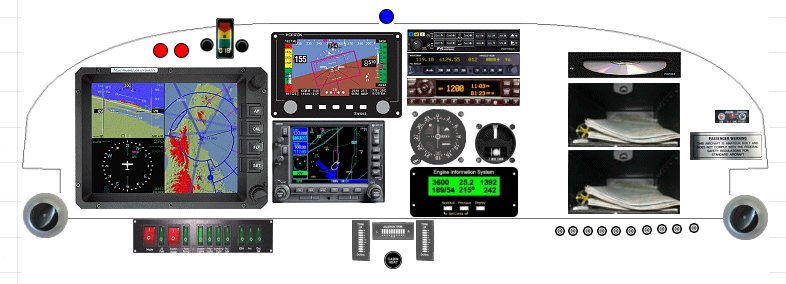 So, this is the
latest layout. I did some research and got the following component
depths:
So, this is the
latest layout. I did some research and got the following component
depths:
| GNS530 | 11" |
| GTX330 | 11.25" |
| SL30 | 10.5" |
| PMA7000CD | 6.8" |
The PMA7000CD may push the rest of the stack down far enough so the long Garmin boxes will clear the bottom of the fwd canopy frame. I will measure it when I get home, and see if this will work. I may end up ditching the EIS4000 (put it behind panel), OBS head, and/or turn coordinator.
Spent a few hours searching the Internet for places where I can request price quotes for the 4 big avionics purchases remaining (the 4 listed above). Sent an email to about 25 places, including some (like Gulf Coast) that I know suck and are unresponsive. Let's see how many companies will respond to a knock on their door by someone with money in hand. What do you guess; maybe 50%; we'll see. 4.0 hr
I also came across this very interesting shootout between the main GPS/nav/comm choices. The results paralleled what I determined on my own: http://www.avionicswest.com/archive/shootout.htm MARCH, '07 - THIS LINK IS BAD NOW, BUT I AM TRYING TO FIND THE SOURCE DOC, SO I CAN POST IT HERE. MAY '07 - Despite MANY emailed requests over the last few months, this guy does not respond at all. What a jerk! HERE is a thread comparing the Garmin 430 vs 480
Aug 21 - Raining very hard at the track. Skipped practice in the rain, and spent a few more hours on panel research. I got a reply to my email to Eckhard Straeter, the local avionics dealer (Advanced Avionics). It's so odd to find a certified avionics shop in a little town WAY out in the woods, where there is no airport anywhere nearby! I guess he travels around to the airports in NH & VT. Anyway, his reply sounds promising, and he's going to call me later. He says he recommends the Garmin audio panel over the one from PS Engineering. When I chat with him, I'll get more details. He also says
I had heard something like that before. I will have to get with him to get details of how that will work; what "complete and tested harness" means, with regard to just the Garmin stuff, rather than the entire panel. I also exchanged emails with Mike Casey, regarding his Eggenfellner electric wiring diagrams. He's almost ready to fly. Also sent out a few more RFQ emails. 5.5 hr
Aug 22 - working on emails & research on antennas. Found Bob's Antennas email link & exchanged a couple emails with Bob Archer. That looks like a great source for antennas that are out of the airstream. Be aware that, if you email Bob, his email is set up that you will get an automatic response back, to which you must click on a link & fill out a small form. Kind a hassle at first, but you only have to do it once, then you're "in". Added "Vendors" page to web site, to summarize my experiences with The Great, The Good, The Bad, and The Ugly. Spent several hours working on Subaru electrics; Bob Knuckolls CD, Fred Stucklen CD, Dan Checkoway CD, Subaru list, printing out & studying EXPBUS replacement circuit emails and schematics. 7.0 hr
Aug 23 - started getting responses to my RFQ email over the weekend. Here's how the vendors shape up, listed in the order in which they responded:
| VENDOR | WEB SITE | # DAYS TO RESPOND | BASE QUOTE (apples to apples) |
| Aircraft Spruce | www.aircraftspruce.com | x | email addresses from Garmin dealer list bounced |
| North Coast Aircraft Radio, Cleveland | www.airradio.com | x | email bounced |
| Tropic Aero | www.tropicaero.com | 1 | said they'd get back with a quote - DIDN'T |
| John Stark | www.starkavionics.com | 1 | $18,205 |
| Aircraft Spruce | www.aircraftspruce.com | 1 | $18,401 - said they'd get back with clarifying info - DIDN'T |
| Pacific Coast Avionics | www.pca.aero | 1 | $19,285 |
| Southeast Aerospace | www.seaerospace.com | 1 | $21,410 |
| Eckhard Straeter | none | 1 | $18,800 |
| Custom Avionics | www.customavionicsfl.com | 2 | $21,450 |
| Avionics Place | www.avionicsplace.com | 2 | said I should use a local shop |
| Avionics Systems | www.avionikits.com | n/a | $20,250 |
Spent much of the afternoon and evening studying avionics bids, considering various possibilities, wondering about even more backups to backups (turn coordinator, attitude indicator, etc). Spent about an hour on the phone with Eckhard, the local avionics shop guy, talking about options. Gotta get away from the computer & papers, and get back on the PLANE. 5.5 hr
Aug 24 - From the quotes I am receiving, I am finding that, apparently because Garmin (and others?) have the dubious business practice of enforcing what they call MAP, or Minimum Advertised Price, the quotes you will get are GREATLY lower than the prices the dealers post in their catalogs & web sites. So, keep that in mind when planning your panel. For instance, if you think you might need $15K (plus installation) (or maybe around $13-13.5K, as listed in the catalogs and web sites of places like Pacific Coast Avionics, Aircraft Spruce, etc) for the Garmin GNS530, you will find that most everyone's privately quoted price, with harness, is more like $10K, or even as low as $9725. BIG difference! You DEFINITELY need to get quotes for your avionics. Don't go by the prices in the catalogs and web sites, and sure as hell don't PAY that much. In hindsight, I MAY have been able to get my Blue Mountain and Grand Rapids EFIS systems at least somewhat cheaper through one of these dealers. Oh well. Also busy studying choices for what encoder to use with my transponder, and trying to decide between the PS Engineering 7000CD vs Garmin 340. 3.0 hr
Aug 25 - Called Van's with some questions about the subpanel, regarding my avionics planning. I asked Bruce if there were any restrictions on cutting instrument access or lightening holes in the subpanel. He said there were not. He also said I should be sure to support my radio trays at the subpanel. I decided I will also need to order the Panel Planner software, as I am now going to do my own panel. I wasted about an hour dicking around on One Mile Up's web site. The software is not cheap, there's no demo, there are no details about the software on the web site. I sent them an email with some questions about the software & to confirm if they have a money back guarantee. Working on the canopy frame is TEDIOUS, so I took lots of breaks throughout the afternoon and evening to work on avionics stuff. I eventually decided to forget the canopy for the night, and study audio panel choices again. I sent an email to David about my decision to go with Eckhard. Exchanged some emails with Eckhard about audio panel choices and about getting a standalone comm recorder. He didn't know of any. I found an ad for one in the AOPA mag, but it looked kinda hokey, compared to the built-in one with the PS Engineering audio panel, it costs $500, and it had a bunch of checklist stuff I don't need. Also, it just plugs into the headphone line, so I can always add it at any time. I was also looking over my altitude encoder choices. I decided I might as go with the Garmin one (Sandia SAE5-35). 3.5 hr
Aug 26 - I remain totally amazed at how many loser companies there are in this avionics business. And this is some expensive stuff I am talking about buying from them! They spend lots of money going to the air shows and advertising, yet they don't have the sense or courtesy to respond to someone who is ready to buy from them. Out of at least 25 RFQs I sent out, I got 7 responses. As expected, companies where I've already experienced extremely poor responsiveness and customer service, such as Gulf Coast Avionics and Aerotronics, did not bother to reply. Neither did several other big names, like Chief Aircraft, JA Air, and too many other losers to bother listing. Aircraft Spruce didn't bother replying to me, as promised, about some questions I asked them to clarify what their quote comprised. I ended up choosing Eckhard Straeter. His price was reasonably low, and it included "custom made wiring harnesses, assisting with installing it in aircraft, checkout in aircraft, activation of 2 year Garmin warranty once the airplane flies, and Transponder/Static altimeter-encoder correspondence check". Since he's local, and used to traveling to the customer, I just can't beat that for support. If I hadn't gone with Eckhard, I'd have definitely gone with John Stark. He had the best deal, and he was the quickest to respond with a quote. I sent him a couple other emails, clarifying what the quote included, and he always responded very quickly. His quote was no BS - it included everything, like trays, wiring, etc. I would highly recommend him if you're making your own panel. He was highly recommended by Walter Tondu, too, and it's easy to see why. If you're going to have someone build your panel, David at Avionics Systems was very responsive to me. In the end, I decided to do my own panel, with help from Eckhard.
I spent some time trying to decide which audio panel to go with. I called my friend Rusty Sachs, the head of NAFI, and asked him about it, and what he thought of the difference in how the marker beacon signals work between the PSE and the Garmin. I also asked him about the practical usefulness of the comm recorder. He didn't feel it'd be all that useful, and he said the analog fade-in, fade-out characteristic of the Garmin marker beacon was more useful than the digital, "it's all there or it's not there at all", beacon on the PSE. So, that clinched it for the audio panel. Rusty also spoke very highly of Eckhard, as has everyone else I've mentioned his name to. I emailed Eckhard and told him to go all Garmin on the stack. Eckhard also recommended that I just get the trays for now. That way, if there are any changes in the equipment between now & the time I actually install it, I won't have old hardware sitting on the shelf. Then, I went back to that pesky canopy frame. Later, I came back on a break from that tedium and spent an hour looking at turn coordinator choices, then back to the canopy frame. 3.0 hr
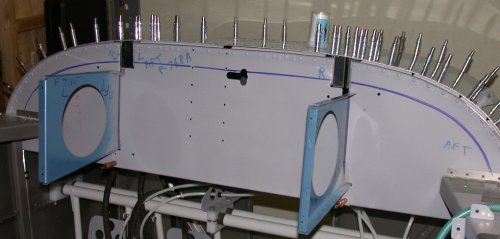 I marked where
the canopy frame fwd channel covers the subpanel, and I will thus be unable
to cut the subpanel or locate any long instruments above that line.
This caused me to have to rearrange the Garmin stack, as well as to put the
GRT EFIS on top of the second column, instead of the GNS530, as
planned. I also marked where the F745s come out of the subpanel.
I will be cutting off the LT one and moving it to the RT to clear the Blue
Mountain EFIS/1 display.
I marked where
the canopy frame fwd channel covers the subpanel, and I will thus be unable
to cut the subpanel or locate any long instruments above that line.
This caused me to have to rearrange the Garmin stack, as well as to put the
GRT EFIS on top of the second column, instead of the GNS530, as
planned. I also marked where the F745s come out of the subpanel.
I will be cutting off the LT one and moving it to the RT to clear the Blue
Mountain EFIS/1 display.
Aug 27 - numerous avionics phone calls, such as to One Mile Up (Panel Planner), Mid-Continent (order Turn Coordinator), Tru-Trak (ask if their system will drive BMA servos), Blue Mountain (ask about a/p refund). When I got my Blue Mountain EFIS, I didn't understand how the a/p worked. I thought it was driven from the EFIS. I assumed if BMA EFIS, then BMA A/P. Not necessarily so. I recently found out that the Tru-Trak autopilots have their own built-in attitude referencing system. So, I should have gotten that, as a third backup to attitude reference. If I hadn't already spent such huge amounts of time & effort modifying the wings & fuselage to accept the BMA servos, I'd send them back for a refund & get the Tru-Trak. So, I was sure the Tru-Trak wouldn't drive the BMA servos, but I called Tru-Trak, just to make sure and to talk about it some. I talked with Jim, who I think is the main guy there. He was very knowledgeable and helpful. Boy, after talking to him, it sure does sound like the T-T would have been a better way to go. Even if you ignore any arguments about which one is better (I've heard the BMA software is not fully debugged yet, but I imagine it will be by the time I fly), the T-T sure would have been a hell of a lot easier to install. Jim said his servos come with complete installation kit for RVs, including all servos, rods, rod ends, easy installation instructions, etc. He said it's a quick and simple installation, even in a completed plane. Sure is some different than what I went through to install the BMA a/p. He said his Digiflight II with GPSS and vertical steering is $5250 and $4350 without vertical steering. He also has a model with ILS. He said his is able to take full advantage of the GNS530, and can do stuff like holding patterns. It's beginning to sound like even the trouble of undoing the BMA servos might be worth it. I called BMA about returning the a/p, and was told I needed to talk to Shelia, who is out, so I sent her an email about it. I was also considering other Turn Coordinators, the Tru-Trak pictoral T&B for $445, the Ray Allen for $627, and the ACS for $676. The Mid-Continent 1394T100-3Z is $669; they have the brushless -3A, with about triple the MTBF, but it is 24v only. I later wasted hours on phone calls to One Mile Up, and spent much of the evening trying unsuccessfully to download my Panel Planner purchase. 7.0 hr
Aug 28 - I couldn't get the damn Panel Planner product download to work last night or this morning. Even though it was Saturday morning, I decided to take a chance and call the One Mile Up support line. I got Gene, who was quite helpful and got me the product from their FTP site. Spent most of the rest of the day screwing around with Panel Planner. Also spent about an hour updating Other Builders page on web site. 6.0 hr + 1.0 doc
Aug 29 - Screwing around with Panel Planner. 3.5 hr
Aug 30 - Panel Planner portrayed the 3Z as a turn & bank indicator and the 3TZ as a turn coordinator. Called Mid-Continent. Larry said the 3Z I ordered has the standard turn coordinator airplane image, so Panel Planner must be wrong. Also looking into reamers to order. 2.0 hr
Aug 31 - Working on panel layout and planning. Working on transponder, altimeter, & encoder requirements research. Big question about whether the encoder built into the BMA EFIS is legal to hook to the transponder. Eckhard says no & I need to order the Sandia TSOd encoder. BMA list (after much discussion) says the BMA encoder is legal to use. 5.5 hr
 Got my Hobbs meter I bought from
Steve Hurlburt, a builder in Ontario.
Got my Hobbs meter I bought from
Steve Hurlburt, a builder in Ontario.
BACK TO MY RV BUILDER'S HOME
BACK TO BRIAN'S HOME